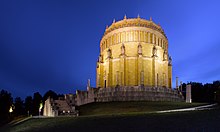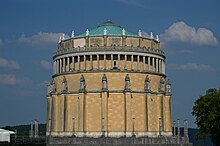Liberation Hall
The Liberation Hall is a monument on the Michelsberg above the town of Kelheim in Lower Bavaria . Seen from Regensburg , it stands upstream of the Danube at the confluence of the Altmühl or the Main-Danube Canal with the Danube . The Liberation Hall was built from 1842 to 1863 in memory of the battles won against Napoleon during the Wars of Liberation from 1813 to 1815. The building was commissioned by King Ludwig I of Bavaria .
history

Airmail card No. 656 of the Flugphoto Verlags-Gesellschaft , around the beginning of the 1920s
In 1842 Ludwig's Walhalla near Regensburg on the Danube was inaugurated. The construction of the Liberation Hall was started in the same year by Friedrich von Gärtner based on ancient and Christian central building ideas, but had to be briefly interrupted in 1847 with the death of Gärtner. The king commissioned Leo von Klenze with the continuation of the building. Just three months later, he presented the first plans that left Gärtner's basic concept unchanged, but added other classicist elements. Finally, in the spring of 1848, construction work resumed. Between 1850 and 1856, gardener's pupil Otto von Langenmantel (1816–1875) was the site manager . He lived at the construction site where his son, the painter Ludwig von Langenmantel , was born in 1854 .
At the laying of the foundation stone on October 19, 1842, choir singing for a four-part male choir was played, composed by the Royal Bavarian Court Music Director Joseph Hartmann Stuntz . The king himself wrote the text:
1. Hail to you, brave men, courageous warriors, you who
won the hero's
wreath, hail to you, loyal Germans, brave victors!
Your deeds will shine forever.
2. It had surrounded us dull and dark,
and there was no more Germany then;
But you swing it to life again,
Victorious it rises again and noble!
3. That discord shamefully chained us,
This will never and never be forgotten,
That unity alone saved us,
Which our homeland gave fame and victory.
4. Through the vast distance of time,
always loop the sacred bond of unity,
In the German soul penetrate it,
then the fatherland remains undefeated.
Leo von Klenze changed the plans at the king's behest and completed the construction in 1863. The opening ceremony took place on October 18, 1863, the 50th anniversary of the Battle of Leipzig .
architecture

The mighty-looking round building made of Kelheim limestone rests on a three-tiered base that is designed as an eighteenth corner. The outer facade is subdivided by 18 buttresses , which are crowned by 18 colossal statues of Johann Halbig as allegories of the German tribes that took part in the battles. These are: "Franconia, Boehmen, Tyroler, Bayern, Oesterreicher, Prussen, Hanoveraner, Maehren, Sachsen, Schlesier, Brandenburger, Pommern, Mecklenburg, Westphalen, Hessen, Thueringer, Rheinlaender, Schwaben" (all around in this order with an arbitrarily chosen beginning) .
The circular hall has a height of 45 m and a diameter of 29 m. Its interior is illuminated by a dome. The inner gallery can be reached via 82 steps. After another 40 steps you reach the outer viewing terrace, from which you have a wide view of the Danube and Altmühl valleys. Since the 2008 season, the domed hall has also been accessible by elevator for wheelchair users and people with reduced mobility.
The interior of the hall is designed as a large domed hall, which is illuminated by an opaion in the top of the dome. The walls are structured by 18 segmented arched niches , above which there is an area for inscriptions, and a final gallery of columns in Tuscan order . In front of the niches that bear the names of the battles of the Wars of Liberation, there are two 3.30 m high goddesses of victory , so that there are a total of 34 statues. The goddesses of victory shake hands in a solemn dance, with the exception of the two figures standing right next to the entrance. The latter were made of white marble from Tyrol. Since this was very expensive, the remaining Victorias were made of white Carrara marble. They were designed by Ludwig Schwanthaler , who also made two Victorias himself, namely the two end figures at the entrance. The other still images were u. a. created by the sculptors Arnold Hermann Lossow and Max von Widnmann . In the niches there are 17 gold-plated bronze shields between two Victorias, which, like the 7 m high entrance gate of the hall, were cast from captured artillery. The large number of goddesses of victory who shake hands here in a gesture of unity refers to the member states of the German Confederation , which fluctuated between 35 and 39 in real terms. The monument thus also contained a commitment to the political status quo , in this case to princely federalism in Germany , which, in contrast to the establishment of an all-German nation-state demanded by the bourgeoisie, meant extensive independence of the individual German states.
The obvious preference for the number 18 is due to the fact that both the Battle of the Nations near Leipzig and the Battle of Waterloo took place on an 18th day of the month. It can also be found in the number of 54 columns and 54 pillars (3 × 18), in the twice 36 columns in the upper gallery (2 × 18) and in the inscriptions for 18 generals and recaptured fortresses each.
The motto of King Ludwig I embedded in the marble floor reminds of the occasion for the erection of this monument:
LIKE TO
THE Germans
NEVER FORGET WHAT
THE LIBERATION STRUGGLE
necessary MADE
AND WHICH THEY
WON.
Above the ornamented door frame of the entrance portal is the dedication:
THE TEUTSCHEN
LIBERUNGSKAEMPFERN
LUDWIG I
KOENIG VON BAYERN
The colossal statues
18 statues on the outside of the Liberation Hall in Kelheim represent German tribes and regions. The height of the statues is each 580 cm. They were created based on models by the sculptor Johann Halbig and have inscriptions in capitals .
Fossils
Geologists found up to 5 cm large, radial feeding traces of lugworms in the green sandstone of the stairs to the Liberation Hall. They show that 100 million years ago a Wadden Sea with nutrient-rich silt existed in the vicinity of Kelheim.
Visitor facilities
In April 2004 a visitor center was opened, in which the museum shop, a small bar, exhibition and lecture rooms are located. In order not to impair the monumental structure, the new building was placed separately on the slope edge.
In the summer, the street-bound tourist train Ludwigsbahn runs from the pier through the old town to the Liberation Hall. These trips are integrated into the VLK as line 100 .
Refurbishment and new color scheme
From April 2015 to the end of 2018, the facade of the Liberation Hall was renovated. The demanding work on the approximately 5,000 square meter area will be followed by the repair of the three-tier base and the large open staircase by the end of 2018. The brick building, plastered in imitation of ashlars, has been given a new coat of paint after more than fifty years. The darker mustard-yellow to ocher-colored appearance has given way to a light, limestone-like, warm-toned color scheme. The recovery of the color spectrum from 1863 was achieved by the harmony of five colors, predominantly ivory, light yellow, delicate green and delicate pink and red tones. Expert statements emphasize a historically correct, scientifically sound and aesthetically appealing “architecture of perception” that corresponds to the intentions of the client and the architect Leo von Klenze. According to the palace administration, experiences with the brightened color palette of the Munich Klenzebauten were included in the planning.
literature
- Ernst Trost : The Danube. Curriculum vitae of a stream . Fritz Molden Verlag, Vienna 1968.
- Christoph Wagner (Hrsg.): The Liberation Hall Kelheim. History - Myth - Present . Schnell & Steiner, Regensburg 2012, ISBN 978-3-7954-2617-0 .
- Christoph Wagner : “The Hall of Liberation in Kelheim as 'architecture of perception'. Sightseeing and political iconography ”, in: The Liberation Hall Kelheim. History, Myth, Present (Regensburg Studies on Art History, 18), ed. by Christoph Wagner, Schnell & Steiner Verlag, Regensburg 2012. ISBN 978-3-7954-2617-0 , pp. 35–54.
- Manfred F. Fischer (editor): Liberation Hall in Kelheim. Official leader. 861-940. Tausend, Bavarian Administration of State Palaces, Gardens and Lakes, Munich 1991.
Web links
- Bavarian Administration of State Palaces, Gardens and Lakes
- Virtual tour: indoor and outdoor facilities (Flash player required)
- Extensive information page about the Liberation Hall
- Liberation hall near Kelheim in the Altmühltal
- Aerial photos of the Liberation Hall
Individual evidence
- ↑ The song to listen to on the website of the Bavarian Administration of Palaces, Gardens and Lakes. August 30, 2013, accessed August 30, 2013 .
- ↑ Researchers found traces of lugworms on the steps to the Kelheim Liberation Hall. Der Standard, December 5, 2012, accessed December 5, 2012 .
- ^ New construction of the visitor center at the Liberation Hall in Kelheim ( memento of November 29, 2014 in the Internet Archive ) , project description by the Landshut State Building Authority
- ↑ Homepage www.ludwigsbahn-kelheim.de
- ↑ Timetable for the VLK 100 line ( memento of July 2, 2015 in the Internet Archive ) on the website of the Kelheim district transport association
- ↑ Elfi Bachmeier-Fausten: A color effect in the sense of the king . In: Mittelbayerische Kelheim from March 24, 2015
- ↑ Wolfgang Wittl: Colored Debate. The Liberation Hall is getting a new coat of paint . In: Süddeutsche Zeitung number 68 of March 23, 2015, Bavaria part
- ^ Bavarian Administration of State Palaces, Gardens and Lakes, Thomas Aniol: Bavarian Castle Administration | Press | Press releases. Press release No. 237/15. June 3, 2015, accessed March 5, 2017 .
Coordinates: 48 ° 55 ′ 6 ″ N , 11 ° 51 ′ 38 ″ E
































